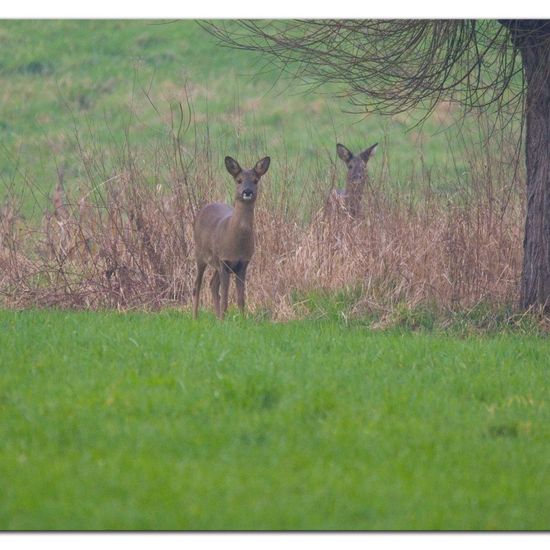
"Während der Brunft – Mitte Juli bis Mitte August – verlässt die Ziege tagsüber ihr(e) Kalb(e) und macht sich auf die Suche nach einem kräftigen, gesunden Bock, um für den Nachwuchs im nächsten Jahr zu sorgen. Die Suche ist gegenseitig, aber besonders die Ziege sucht die Ziege. In der Brunftzeit sind Ziegenbock und Ziege oft gleichzeitig zu sehen: Der Ziegenbock, der der Ziege folgt, um sie zu beschlagen (Paarung). Nachdem die Ziege getrieben wurde, müttert sie allein das/die im Frühjahr geborene(n) Kalb(e)." says Danny VG in habitat Agriculture on 26.01.2022. Capreolus (Capreolus) is a genus of mammals.
Post your nature observations of Animal sightings in the NatureSpots App, too! #NatureSpots #Animal #Agriculture
By User: Danny VG
Posted in: Animal > Capreolus


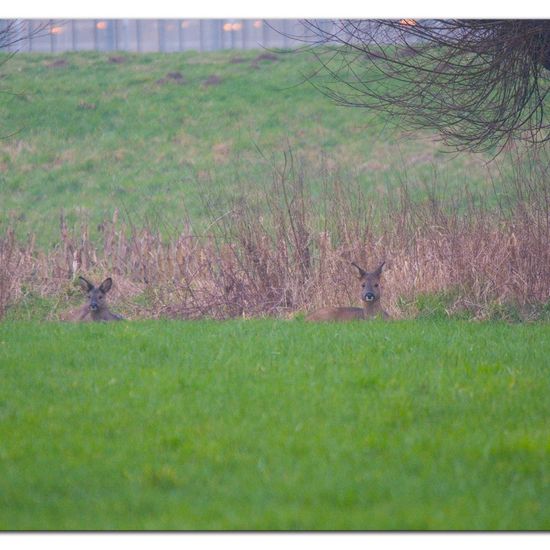 "Nach dem Winter fallen die Schanzen wieder auseinander. Der Ziegenbock, der fast ein einjähriger Ziegenbock ist, wird von der Ziege verjagt. Kurz bevor die neuen Kälber gesetzt (geboren) werden, vertreibt die Ziege auch ihre Tochter, das schmale Reh. Allerdings kommt es regelmäßig vor, dass das kleine Reh nach der Geburt der neuen Kälber zu ihrer Mutter zurückkehrt. Im Spätherbst gesellt sich oft ein Bock dazu; der Auftakt zu einem Wintersprung." says Danny VG in habitat Agriculture on 26.01.2022. Capreolus (Capreolus) is a genus of mammals.
"Nach dem Winter fallen die Schanzen wieder auseinander. Der Ziegenbock, der fast ein einjähriger Ziegenbock ist, wird von der Ziege verjagt. Kurz bevor die neuen Kälber gesetzt (geboren) werden, vertreibt die Ziege auch ihre Tochter, das schmale Reh. Allerdings kommt es regelmäßig vor, dass das kleine Reh nach der Geburt der neuen Kälber zu ihrer Mutter zurückkehrt. Im Spätherbst gesellt sich oft ein Bock dazu; der Auftakt zu einem Wintersprung." says Danny VG in habitat Agriculture on 26.01.2022. Capreolus (Capreolus) is a genus of mammals. 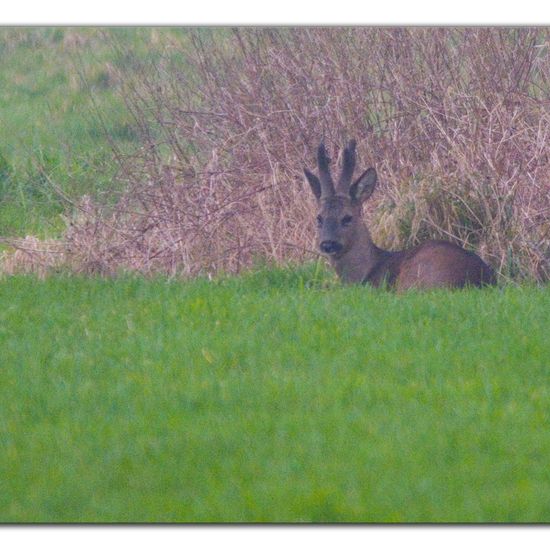 "Am Ende des Herbstes, gegen Winteranfang, gehen die Sommerschanzen in die größeren Winterschanzen über. Diese Sprungbildung wird hauptsächlich durch das Nahrungsangebot und das Bedürfnis nach Ruhe und Sicherheit ausgelöst. Regelmäßige Wintersprünge sind zum Beispiel eine Ziege mit Kälbern, ein schmales Reh (Tochter) aus dem Vorjahr und ein erwachsener Ziegenbock. Springt von vier auf fünf Tiere. In strengen Wintern vereinen sich mehrere Winterschanzen zu einer großen Schanze mit teilweise zwanzig Rehen. Im freien Feld treten viel größere Sprünge auf." says Danny VG in habitat Agriculture on 26.01.2022. Capreolus (Capreolus) is a genus of mammals.
"Am Ende des Herbstes, gegen Winteranfang, gehen die Sommerschanzen in die größeren Winterschanzen über. Diese Sprungbildung wird hauptsächlich durch das Nahrungsangebot und das Bedürfnis nach Ruhe und Sicherheit ausgelöst. Regelmäßige Wintersprünge sind zum Beispiel eine Ziege mit Kälbern, ein schmales Reh (Tochter) aus dem Vorjahr und ein erwachsener Ziegenbock. Springt von vier auf fünf Tiere. In strengen Wintern vereinen sich mehrere Winterschanzen zu einer großen Schanze mit teilweise zwanzig Rehen. Im freien Feld treten viel größere Sprünge auf." says Danny VG in habitat Agriculture on 26.01.2022. Capreolus (Capreolus) is a genus of mammals.  "Während der Brunft – Mitte Juli bis Mitte August – verlässt die Ziege tagsüber ihr(e) Kalb(e) und macht sich auf die Suche nach einem kräftigen, gesunden Bock, um für den Nachwuchs im nächsten Jahr zu sorgen. Die Suche ist gegenseitig, aber besonders die Ziege sucht die Ziege. In der Brunftzeit sind Ziegenbock und Ziege oft gleichzeitig zu sehen: Der Ziegenbock, der der Ziege folgt, um sie zu beschlagen (Paarung). Nachdem die Ziege getrieben wurde, müttert sie allein das/die im Frühjahr geborene(n) Kalb(e)." says Danny VG in habitat Agriculture on 26.01.2022. Capreolus (Capreolus) is a genus of mammals.
"Während der Brunft – Mitte Juli bis Mitte August – verlässt die Ziege tagsüber ihr(e) Kalb(e) und macht sich auf die Suche nach einem kräftigen, gesunden Bock, um für den Nachwuchs im nächsten Jahr zu sorgen. Die Suche ist gegenseitig, aber besonders die Ziege sucht die Ziege. In der Brunftzeit sind Ziegenbock und Ziege oft gleichzeitig zu sehen: Der Ziegenbock, der der Ziege folgt, um sie zu beschlagen (Paarung). Nachdem die Ziege getrieben wurde, müttert sie allein das/die im Frühjahr geborene(n) Kalb(e)." says Danny VG in habitat Agriculture on 26.01.2022. Capreolus (Capreolus) is a genus of mammals. 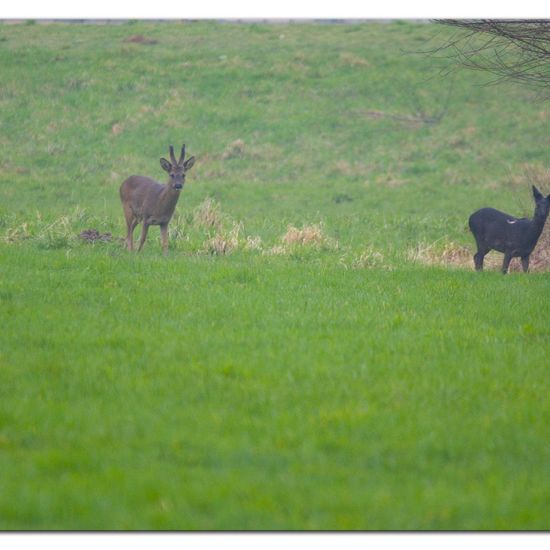 A discovery by Danny VG in habitat Agriculture on 26.01.2022. Capreolus (Capreolus) is a genus of mammals.
A discovery by Danny VG in habitat Agriculture on 26.01.2022. Capreolus (Capreolus) is a genus of mammals. 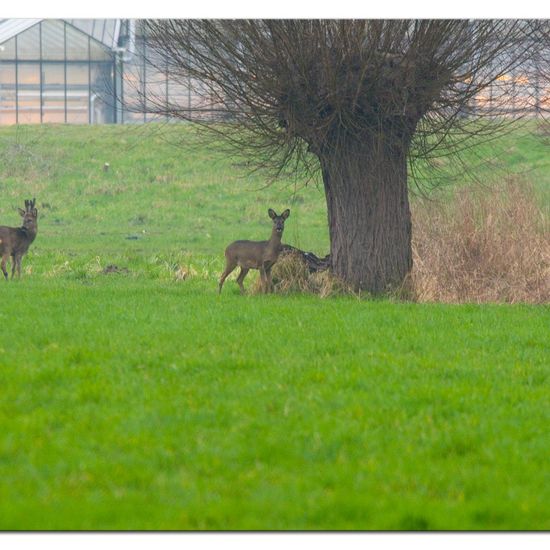 "Eine Gruppe von Hirschen wird als Sprung bezeichnet. Sprünge finden nicht das ganze Jahr über statt. Das ist wirklich nur in der Winterzeit. Den Rest des Jahres leben Hirsche eher in kleinen Familienverbänden, wie eine Ziege mit zwei Kälbern. Böcke leben normalerweise getrennt. Der Hirsch ist im Grunde ein Einzelgänger.
Nach der Geburt der Kitze im Frühjahr verbringen die Ziege und ihr Nachwuchs den Sommer miteinander: der Sommersprung. Je nach Anzahl der Nachkommen sehen wir Sprünge von zwei oder drei Rehen zusammen. Der schmale Rogen (Kalb vom Vorjahr) gesellt sich oft dazu." says Danny VG in habitat Agriculture on 26.01.2022. Capreolus (Capreolus) is a genus of mammals.
"Eine Gruppe von Hirschen wird als Sprung bezeichnet. Sprünge finden nicht das ganze Jahr über statt. Das ist wirklich nur in der Winterzeit. Den Rest des Jahres leben Hirsche eher in kleinen Familienverbänden, wie eine Ziege mit zwei Kälbern. Böcke leben normalerweise getrennt. Der Hirsch ist im Grunde ein Einzelgänger.
Nach der Geburt der Kitze im Frühjahr verbringen die Ziege und ihr Nachwuchs den Sommer miteinander: der Sommersprung. Je nach Anzahl der Nachkommen sehen wir Sprünge von zwei oder drei Rehen zusammen. Der schmale Rogen (Kalb vom Vorjahr) gesellt sich oft dazu." says Danny VG in habitat Agriculture on 26.01.2022. Capreolus (Capreolus) is a genus of mammals.  A discovery by Danny VG in habitat Agricultural meadow on 26.01.2022. Common Buzzard (Buteo buteo) is a species of bird of prey.
A discovery by Danny VG in habitat Agricultural meadow on 26.01.2022. Common Buzzard (Buteo buteo) is a species of bird of prey. 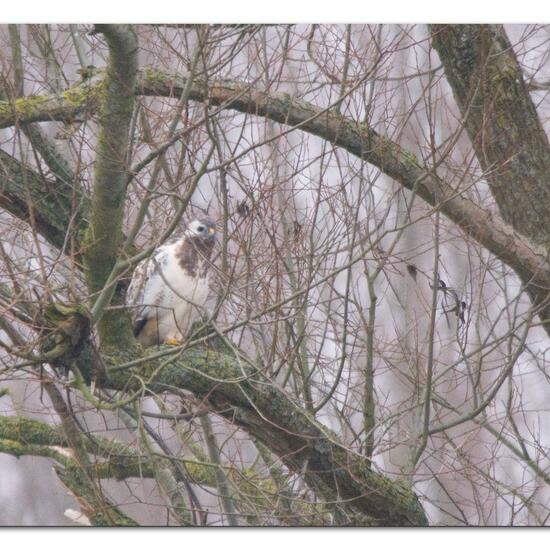 A discovery by Danny VG in habitat Agricultural meadow on 26.01.2022. Common Buzzard (Buteo buteo) is a species of bird of prey.
A discovery by Danny VG in habitat Agricultural meadow on 26.01.2022. Common Buzzard (Buteo buteo) is a species of bird of prey. 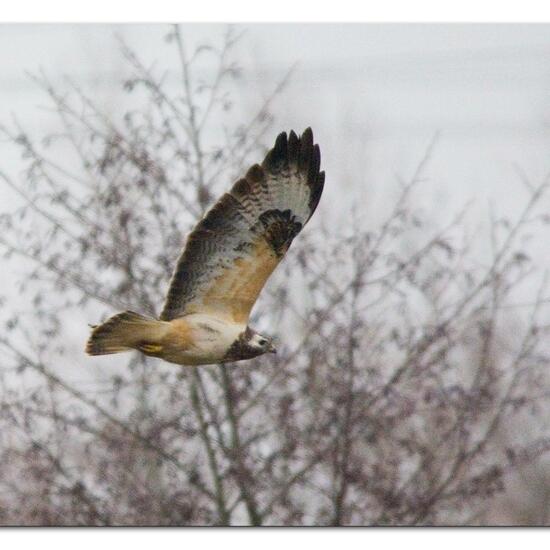 A discovery by Danny VG in habitat Agricultural meadow on 26.01.2022. Common Buzzard (Buteo buteo) is a species of bird of prey.
A discovery by Danny VG in habitat Agricultural meadow on 26.01.2022. Common Buzzard (Buteo buteo) is a species of bird of prey. 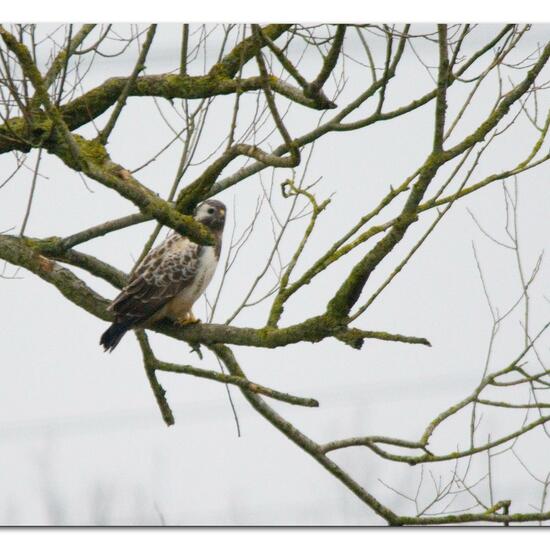 A discovery by Danny VG in habitat Agricultural meadow on 26.01.2022. Common Buzzard (Buteo buteo) is a species of bird of prey.
A discovery by Danny VG in habitat Agricultural meadow on 26.01.2022. Common Buzzard (Buteo buteo) is a species of bird of prey.  A discovery by Danny VG in habitat Garden on 26.01.2022. Forficula auricularia (Forficula auricularia) is a species of insect.
A discovery by Danny VG in habitat Garden on 26.01.2022. Forficula auricularia (Forficula auricularia) is a species of insect.